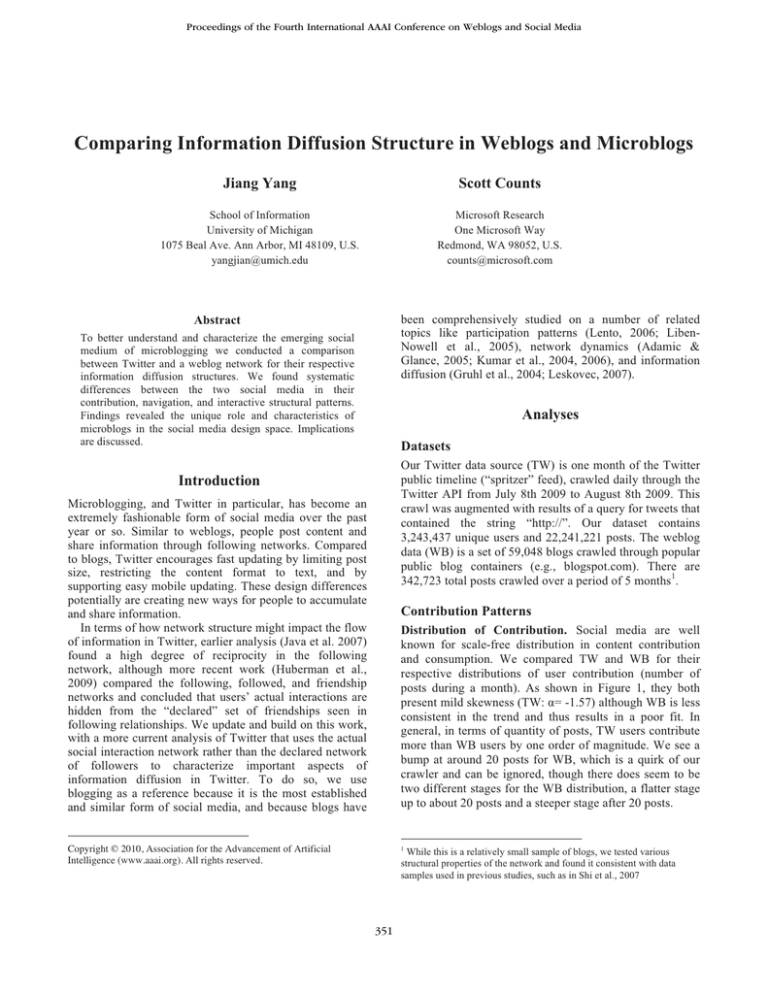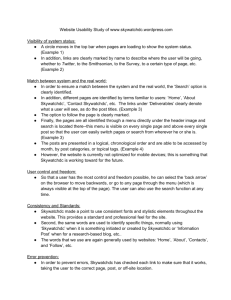
Proceedings of the Fourth International AAAI Conference on Weblogs and Social Media
Comparing Information Diffusion Structure in Weblogs and Microblogs
Jiang Yang
Scott Counts
School of Information
University of Michigan
1075 Beal Ave. Ann Arbor, MI 48109, U.S.
yangjian@umich.edu
Microsoft Research
One Microsoft Way
Redmond, WA 98052, U.S.
counts@microsoft.com
been comprehensively studied on a number of related
topics like participation patterns (Lento, 2006; LibenNowell et al., 2005), network dynamics (Adamic &
Glance, 2005; Kumar et al., 2004, 2006), and information
diffusion (Gruhl et al., 2004; Leskovec, 2007).
Abstract
To better understand and characterize the emerging social
medium of microblogging we conducted a comparison
between Twitter and a weblog network for their respective
information diffusion structures. We found systematic
differences between the two social media in their
contribution, navigation, and interactive structural patterns.
Findings revealed the unique role and characteristics of
microblogs in the social media design space. Implications
are discussed.
Analyses
Datasets
Our Twitter data source (TW) is one month of the Twitter
public timeline (“spritzer” feed), crawled daily through the
Twitter API from July 8th 2009 to August 8th 2009. This
crawl was augmented with results of a query for tweets that
contained the string “http://”. Our dataset contains
3,243,437 unique users and 22,241,221 posts. The weblog
data (WB) is a set of 59,048 blogs crawled through popular
public blog containers (e.g., blogspot.com). There are
342,723 total posts crawled over a period of 5 months1.
Introduction
Microblogging, and Twitter in particular, has become an
extremely fashionable form of social media over the past
year or so. Similar to weblogs, people post content and
share information through following networks. Compared
to blogs, Twitter encourages fast updating by limiting post
size, restricting the content format to text, and by
supporting easy mobile updating. These design differences
potentially are creating new ways for people to accumulate
and share information.
In terms of how network structure might impact the flow
of information in Twitter, earlier analysis (Java et al. 2007)
found a high degree of reciprocity in the following
network, although more recent work (Huberman et al.,
2009) compared the following, followed, and friendship
networks and concluded that users’ actual interactions are
hidden from the “declared” set of friendships seen in
following relationships. We update and build on this work,
with a more current analysis of Twitter that uses the actual
social interaction network rather than the declared network
of followers to characterize important aspects of
information diffusion in Twitter. To do so, we use
blogging as a reference because it is the most established
and similar form of social media, and because blogs have
Contribution Patterns
Distribution of Contribution. Social media are well
known for scale-free distribution in content contribution
and consumption. We compared TW and WB for their
respective distributions of user contribution (number of
posts during a month). As shown in Figure 1, they both
present mild skewness (TW: α= -1.57) although WB is less
consistent in the trend and thus results in a poor fit. In
general, in terms of quantity of posts, TW users contribute
more than WB users by one order of magnitude. We see a
bump at around 20 posts for WB, which is a quirk of our
crawler and can be ignored, though there does seem to be
two different stages for the WB distribution, a flatter stage
up to about 20 posts and a steeper stage after 20 posts.
Copyright © 2010, Association for the Advancement of Artificial
Intelligence (www.aaai.org). All rights reserved.
1
While this is a relatively small sample of blogs, we tested various
structural properties of the network and found it consistent with data
samples used in previous studies, such as in Shi et al., 2007
351
surprisingly, the rate of posts containing a link in WB is
higher, as WB has more space for adding links. However
the rate in TW is also striking as almost one quarter of
posts had an explicit link and more than one third can
potentially route to other users via a mention. This implies
that in addition to considering TW as a medium of selfexpression and conversation, its capacity for providing
reference and navigation on the Web is important.
% posts that contain links
% inbound referring
WB
59.9%
85.96%
TW
24.7%2
2.2%
Mentions
35.2%
35.2%
Table 1: link statistics for two media
Figure 1: Distribution of contribution
Next we compared the destinations that these links point
to (Table 1, row 2; and also Figure 3). The portion of links
pointing to one another within the medium implies the
degree to which a medium is self-sustainable by providing
content and navigating within the medium. TW has very
few tweets linking to other tweets (2.2%), though mentions
(35%) serve this purpose to some extent. In WB, the
majority of links actually point to other posts in the WB
network. This comparison suggests very different
properties of the two media: WB leans toward a function of
internal blog content consumption while TW URLs are
largely one-directional outwards.
Speed of Posting. We would expect that TW has a higher
frequency of both contribution and consumption, since it
encourages short posts and easy mobile posting. In
addition to contribution in terms of numbers, we looked at
how fast users can update new content, which potentially
would be important for understanding the informationgenerating pattern. We used the minimum time interval
between any two sequential posts of a user to quantify the
capability of people to be fast in posting. Figure 2 shows
the comparison, with users grouped by the total number of
posts they had during a month.
Figure 2: Min Interval between 2 posts
In general, Twitter users had smaller minimum intervals
between posts, especially when posting fewer posts (less
than 30 posts per month), where the difference can be as
high as more than one order of magnitude. For example,
for the group who had 10 to 20 posts, the minimum
interval is on average 3 hours for WB and 18 minutes for
TW. However, this difference diminishes when people post
many times, implying that posting speed for high volume
posters reaches a common limit regardless of media type.
Navigation Patterns. We consider any online information
medium to play some part of either (or both) of two roles:
providing information content directly or navigating people
to other sources. For a familiar example, Google, the
largest portal of the Web, mostly serves a navigating
function. Because a link provides a reference and path to
another information source, we analyzed link patterns to
quantify this navigating property of the two media.
There are two types of links in TW: explicit URLs
(normally in a shortened form) and mentions (citing
another user through the @username convention). URLs
are also in WB but mentions happen only in TW. Row 1 of
Table 1 shows the comparison of the link distribution. Not
Figure 3: Web of navigation links
We also examined the difference between the sets of
destination sites from the two media. Since the two sets are
not on the same scale in terms of number of outbound
links, we could only compare the distribution and
qualitative differences. We count the frequency of each
destination site and each blog only counts for one vote for
each site. First we found that WB refers to a more diverse
and scattered set of destination sites. As illustrated in
Figure 3 (showing a sample of the top 15 destination sites),
WB directs to many different websites and each of them
accounts for only a very small portion of the overall traffic.
TW also presents a much higher concentration. For
example, the 30 most frequently referred websites by TW
comprise 32.18% of total links, while this ratio for WB is
only 6.47%. We use the relative dot size and number of
2
Because our main dataset included additional tweets that matched our
“http://” query, we used a different dataset just for this metric. This
second dataset consisted of 5 months of the Twitter public timeline
(1/1/09 6/1/09) sampled every 5 minutes.
352
sites in Figure 3 to visualize this difference. Table 2 lists
the 15 websites most frequently referred by each medium.
We see that for WB, each counts for one percent or less of
the total number of links. TW is more concentrated, with
social networking and media sites like YouTube
dominating, including many sites derived from TW itself
(e.g, twitpic).
WB
Measures
# nodes
# edges
# mutual edges
Clustering Coefficient
SCC
IN
OUT
TUBES
TENDRILS
OTHERS
TW
amazon.com
facebook.com
myspace.com
news.yahoo.com
cnn.com
telegraph.co.uk
foxnews.com
etsy.com
timesonline.co.uk
maps.google.com
reuters.com
bloomberg.com
dailymail.co.uk
politico.com
time.com
0.0124
0.0055
0.0036
0.0031
0.0030
0.0028
0.0026
0.0021
0.0021
0.0018
0.0018
0.0017
0.0016
0.0015
0.0015
twitpic.com
www.youtube.com
twittascope.com
tweeteradder.com
NeedFollowers.com
lolquiz.com
news.google.com
myloc.me
blip.fm
www.facebook.com
www.tweeterfollow.com
www.plurk.com
www.ustream.tv
www.flickr.com
mypict.me
0.0822
0.0437
0.0255
0.0188
0.0165
0.0113
0.0108
0.0108
0.0094
0.0089
0.0077
0.0070
0.0059
0.0052
0.0050
WB
59,048
198,445
4613(2.32%)
0.0076
14.64%
18.23%
12.99%
1.26%
12.02%
40.86%
TW
2,896,784
4,557,124
318,788(7.00%)
0.0031
13.64%
14.96%
8.03%
6.39%
0
56.76%
Table 3. Comparing global structures
edges, which indicates a slightly higher “reciprocal” nature
of TW. We see that the TW network presents lower global
connectedness than the WB network, as shown in the
Bowtie analysis (SCC: Strongly Connected Component
and IN/OUT sets; Broder, et al., 2000).
Interestingly, even with sparse edges and a huge number
of nodes, the TW network presents a clustering coefficient
of the same magnitude as that of the WB network. The
densification law prevalent in many networks suggests that
the number of edges grows superlinearly with the number
of nodes over time: е(t) n(t)α(Leskovec, 2005) and thus all
these measures are sensitive to the size of network. To
accommodate this size sensitivity, we compared the WB
network with a down-sampled TW network and found that
the TW network presents an even higher CC than the WB
network at the same scale. This implies that TW is less
coherent globally, but likely to form tight clusters locally.
Figure 4 visualizes the two networks and we can clearly
see the structural difference. The WB network is more
coherent and forms a central core while there is little core
in the TW network and the nodes tend to cluster in
decentralized small structures.
Next we used motif analysis to assess the microstructural signature of the two networks. We employed
FANMOD, a convenient motif detector tool to uncover the
significant triad motifs in the network (Milo, et al., 2002).
This tool generates a certain number of random networks
with the same number of nodes and edges as the original
network and tests the difference in terms of frequency of
each possible triad motif structure between the original
network and the average of all random networks.
Table 2: top 15 frequent destination sites
Characterizing Network Structure. In these two social
media, information dynamics is mainly realized through
the network of social interactions. Through those
interactions, people spread information, exert influence,
and construct social cognition. For WB, hyperlink citations
have been used to model the network of social interactions
(Gruhl et al., 2004; Leskovec, 2007). In TW, there are two
primary interrelationships among users: following and
mentioning. Similar to citation in a blog, mentioning is an
explicit action that refers or attributes to another user.
Therefore, to be as comparable as possible to links in
blogs, we constructed a social interaction network for TW
based on mentions.
We first compared the global structural characteristics
between the WB and TW networks. Table 3 shows that the
two social media present distinct characteristics in their
global interactive structures (note that WB results based on
our sample are consistent with previous reports (e.g., Shi et
al., 2007). In general, the WB network is much denser than
TW network despite TW having a higher percent of mutual
WB network: Vertices: 3013, Edges: 3667
TW network: Vertices: 3627, Edges: 2297
Figure 4. Visualizing subset of Weblog link network and Micro blog mentioning network, used Microsoft C#UNG
353
forms of social media show different preferences or
efficiencies in spreading different types of information.
Acknowledgements
The authors would like to thank Steve Ickman, Paul Johns,
Matt Hurst, and Scott Golder who helped with data access
and provided discussion insight.
Figure 5. Comparing triad motif (non-sig in grey)
References
Figure 5 compares the degree to which the two networks
deviate from random networks. In general, both networks
tend to form tightly connected structures (closed triangle),
which is consistent with many previous observations on
real social networks (Watts & Strogatz, 1998). The WB
network shows stronger deviation from random networks.
For example, it is extremely significant on the full bidirected triangle (which is not shown in the figure
because the value is too high to be comparable with
others). The WB network is also extremely significant in
the negative direction on structure ID=78, where one blog
has bi-directed links with the other two, but there is no link
between them. Together these results suggest a strong
tendency to form full triangle relationships, when there are
already two bi-directional pairs there.
Furthermore, triad ID=36 is a very popular structure in
the random network (the average frequency was 68.91%).
However the WB network has a significantly, if only
slightly, higher frequency (68.98%) while the TW is not
different from the random network. Thus this motif
structure, likely two blogs referring to a third, is dominant
in the WB network over the TW network.
Adamic, L. A., & Glance, N. (2005). The political
blogosphere and the 2004 U.S. election: divided they blog.
Proceedings of the 3rd international workshop on Link
discovery, Chicago, Illinois.
Broder, A., Kumar, R., Maghoul, F., Raghavan, P.,
Rajagopalan, S., Stata, R., et al. (2000). Graph structure in
the Web. Computer Networks, 33(1), 309-320.
Gruhl, D., Guha, R., Liben-Nowell, D., & Tomkins, A.
(2004). Information diffusion through blogspace.
Proceedings of the 13th World Wide Web.
Huberman, B., Romero, D. M., & Wu, F. (2009). Social
networks that matter: Twitter under the microscope. First
Monday, 14.
Java, A., Song, X., Finin, T., & Tseng, B. (2007). Why We
Twitter: Understanding Microblogging Usage and
Communities. Procedings of the Joint 9th WEBKDD and
1st SNA-KDD Workshop.
Kumar, R., Novak, J., Raghavan, P., & Tomkins, A.
(2004). Structure and evolution of blogspace.
Communications of the ACM, 47(12), 35 - 39.
Kumar, R., Novak, J., & Tomkins, A. (2006). Structure
and evolution of online social networks. SIGKDD.
Lento, T., Welser, H. T., Gu, L., & Smith, M. (2006). The
Ties that Blog: Examining the Relationship Between Social
Ties and Continued Participation in the Wallop
Weblogging System. Paper presented at the WWW Third
Annual Workshop on the Weblogging Ecosystem.
Leskovec, J., Kleinberg, J., & Faloutsos, C. (2005). Graphs
over time: Densification law, shrinking diameters and
possible explanations. Paper presented at the SIGKDD.
Leskovec, J., Krause, A., Guestrin, C., Faloutsos, C.,
Vanbriesen, J., & Glance, N. (2007). Cost effective
outbreak detection in networks. 13th KDD.
Liben-Nowell, D., Novak, J., Kumar, R., Raghavan, P., &
Tomkins, A. (2005). Geographic Routing in Social
Networks. Proceedings of the National Academy of
Sciences, 103(33), 11623-11628.
Milo, R., Shen-Orr, S., Itzkovitz, S., Kashtan, N.,
Chklovskii, D., & Alon, U. (2002). Network motifs: simple
building blocks of complex networks. Science, 298(5594),
824-827.
Shi, X., Tseng, B., Adamic. L. A. (2007) Looking at the
Blogosphere Topology through Different Lenses. ICWSM.
Watts, D. J., & Strogatz, S. (1998). Collective dynamics of
'small-world' networks. Nature, 393, 440–442.
Conclusion & Future Work
This work compared several aspects of the respective
information structures of weblogs and Twitter. We found
that the two forms of social media systematically differ in
the contribution pattern, how they navigate on the Web,
and the network of social interactions. We found that TW
users generally maintain a higher frequency in posting and
both WB and TW present superlinear distribution of
contribution across users. The WB network is more selfsustained with a large percentage of links pointing to other
blog sites. In contrast, most URLs in TW are outbound.
The comparison of the social interaction networks
revealed structural differences between WB and TW. The
WB network is more coherent globally while the TW
network is more decentralized and connected locally. This
indicates a flatter social structure in Twitter and a relative
inapplicability of some social network analysis algorithms
like PageRank. The global disconnectedness also suggests
a limited efficiency in larger scale information diffusion. In
future work, we would like to extend the comparison to the
dynamics of information diffusion such as whether the two
354






